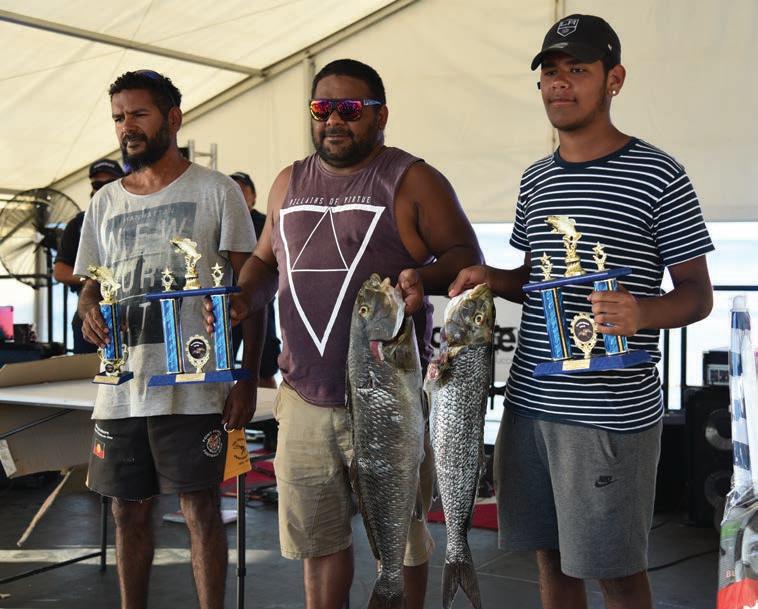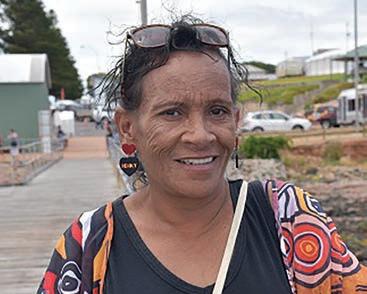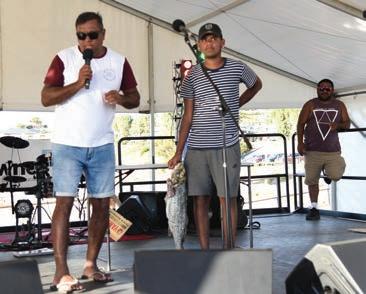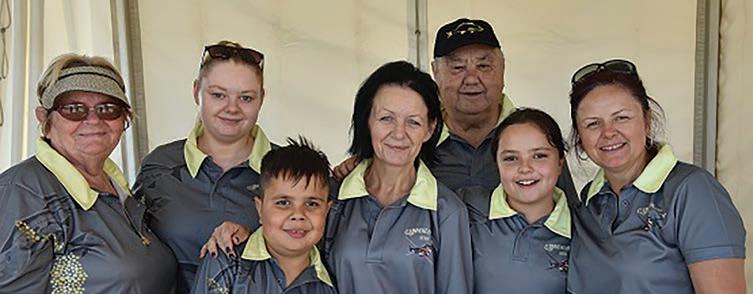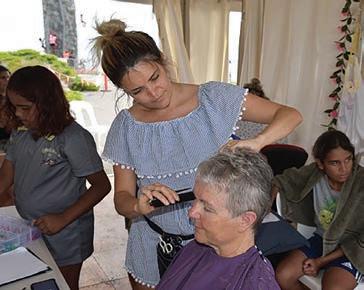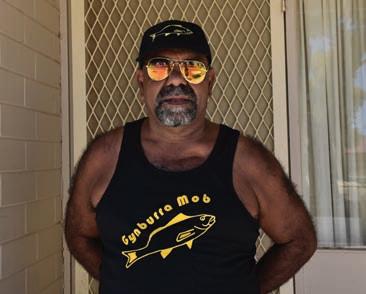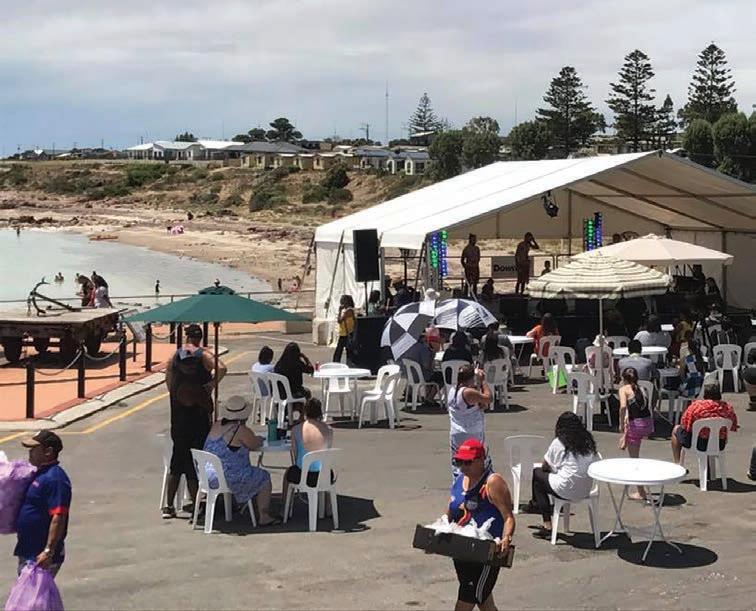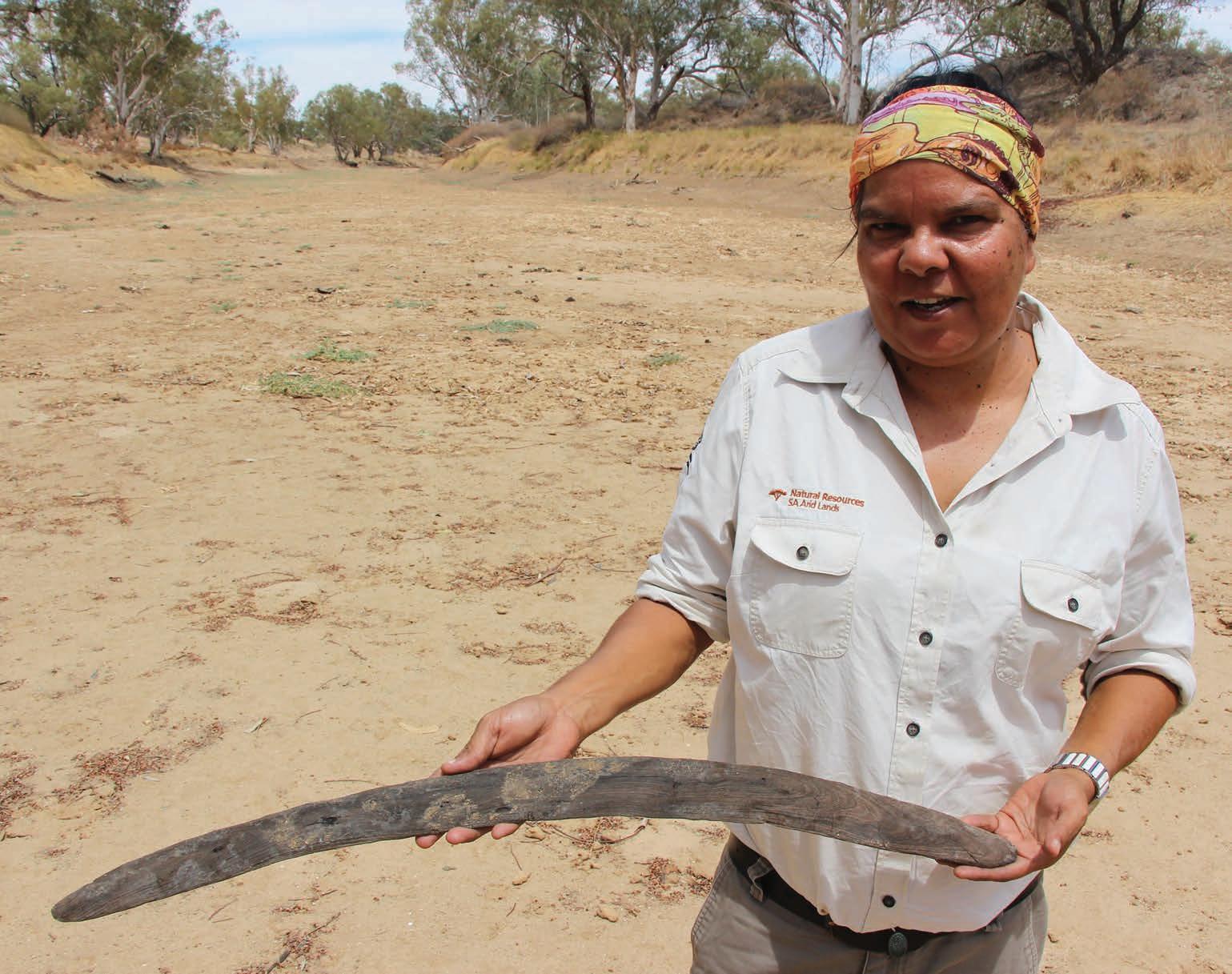
16 minute read
Rare artefacts found by chance reveal ancient culture
Rare ar tefacts found by chance reveal ancient culture
Traditional tools used by ancestors of the Yandruwandha Yawarrawarrka traditional owners have been found by chance near Innamincka, in the far north of the South Australian outback. The chance discovery represents a rare archaeological find and offers an insight into the lives of South Australia’s original inhabitants.
Advertisement
The news that three ancient boomerangs, as well as a digging stick and stone tools have been found by Park Rangers in the Innamincka Regional Reserve is important news for the Yandruwandha Yawarrawarrka Traditional Land Owners Corporation (YYTLOAC). They have been recognised as traditional owners and hold Native Title over the area in the north east of South Australia.
“We’re very excited about this unexpected find,” Chairperson of the YYTLOAC, Joshua Haynes said.
“These objects give us a glimpse of the lives of our ancestors and reminds us how much this country is tied up with our continuing culture.” Mr Haynes said the relationship the YYTLOAC has with the State Government Department of Environment, Water and Natural Resources (DEWNR) through comanagement of the Innamincka Regional Reserve means that the Traditional Owners were the first to be notified of the find and consulted about the objects. It also means once the items have been assessed and possibly dated, DEWNR will return the items to the traditional owners. “For the Yandruwandha Yawarrawarrka people, the discovery of these precious items reinforces the importance of careful cultural management of the area,” Mr Haynes said.
“This country holds our ancestor’s stories but more importantly still holds the physical connection to our ancestry.
It’s important that we, the traditional owners, or those who are working with us, are the ones to care for the country now and into the future.
“As traditional owners we have learnt about this country from our families and these items have a very significant cultural significance” he said.
Unprecedented low water levels in the Innamincka Regional Reserve led to the discovery by National Park Rangers Katheryn and Jason Litherland while they were clearing rubbish left by visitors in a now dry creek bed.
Tony Magor, Manager Parks and Comanagement with DEWNR in the SA Arid Lands Region said the discovery was significant for everyone who works and lives in the area and has generated lots of discussion about the possible uses and ages of the artefacts.
“Our staff work closely with the Yandruwandha Yawarrawarrka people in caring for this country so when the work reveals treasures like this we all share in the excitement of the find and have a deeper appreciation of what this means,” Mr Magor said.
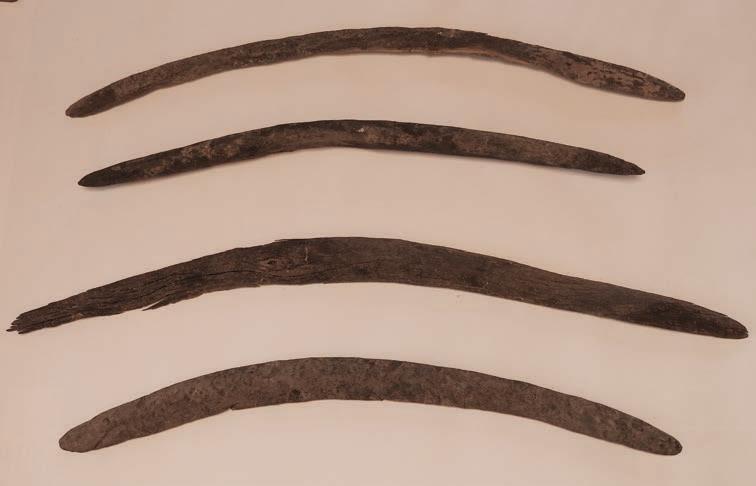
This page, top to bottom: Katheryn Litherland with one of the finds; The wooden artefacts. Opposite page, top to bottom: One of the boomerangs; Jason Litherland with one of the artefacts; One of the artefacts on country; Josh Haynes.
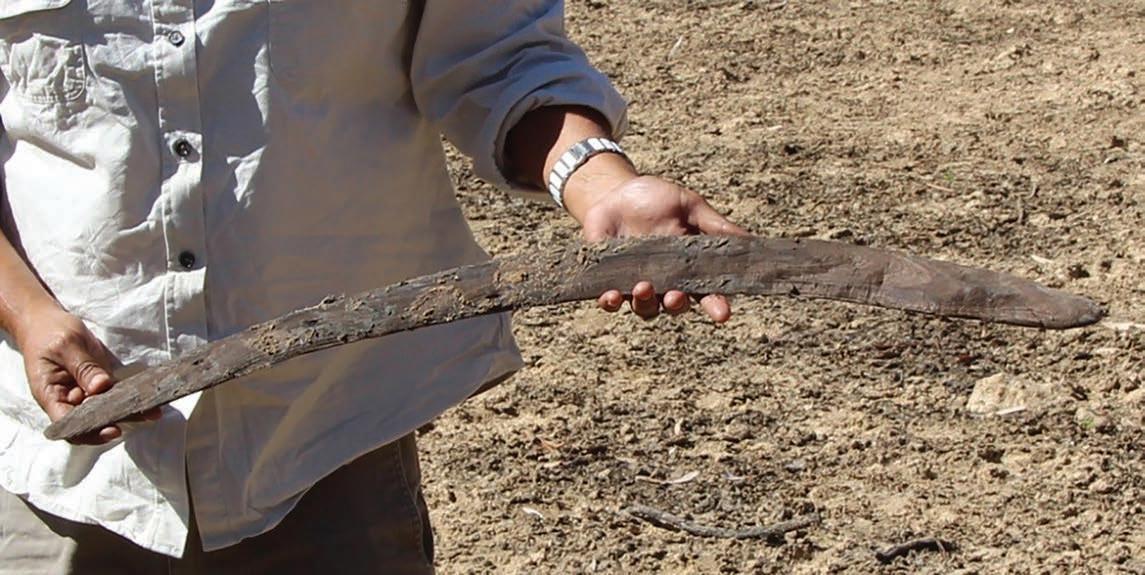

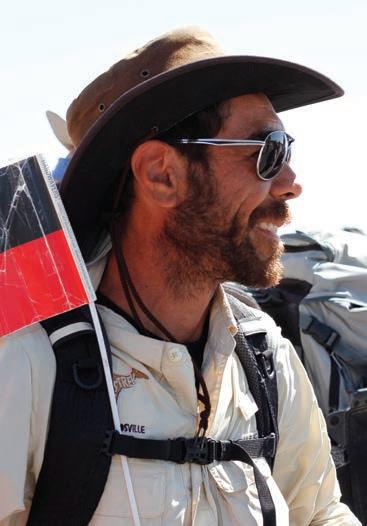
The age of the artefacts is yet to be determined – they could be as young as 100 years old or as much as 10,000 years old. The artefacts need to be managed carefully to maintain their condition and are being stored in controlled conditions pending permanent storage.
Methods of dating to determine their age could include x-ray testing to search for tree rings to use in dendrochronology and radiocarbon dating using accelerated mass spectrometry so that only a very small sample of the artefact would be needed. Other assessments could include studying the method of manufacture of the objects and determining the type of wood including the species of tree that they are made from.
Sean Freeman from Australian Heritage Services (AHA), Consulting Archaeologist for YYTLOAC says that artefacts such as these are significant for the understanding of the culture of Australia’s First Peoples.
There are quite a number of examples of wooden artefacts in museums that have been collected over the last 200 years but there are very few examples that have survived on-country. Many items that were used by the first Australians were made of wood and other organic materials and few have survived, even those of relatively recent age. “With the limited preservation of wooden items, particularly in an arid environment, it’s highly unusual to have articles like this that survive,” Mr Freeman said.
While there is evidence that cultures around the world have used throwing sticks, there is no doubt that Indigenous Australian people can claim the longest continuous association with the boomerang, according to work by Anthropologist Philip Jones. Boomerangs often play a part in creation stories and those stories are re-enacted in song and ceremony, as well as being represented in rock art, painting and carvings.
While the objects are incredibly valuable to all those interested in Australia’s ancient history, they are of no commercial value Mr Magor explained.
“Aboriginal artefacts are protected in South Australia and cannot be removed without proper permission. While objects like this are priceless, there can be no commercial market for their sale as they can’t be sold legally in SA.”
AHS, DEWNR and the YYTLOAC are now looking to bring a world expert on boomerangs and throwing sticks, Mr Luc Bordes from the University of Wollongong to South Australia to study these items and gain a greater understanding of them.
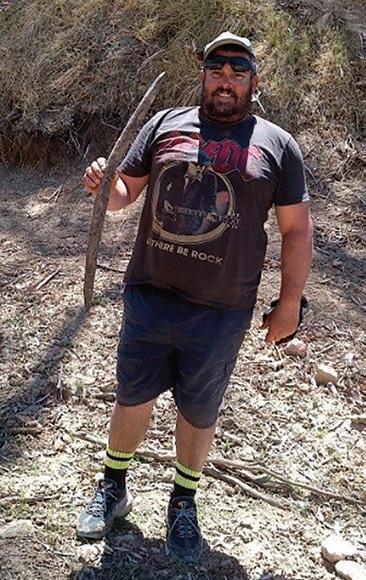
Dreamtime Bags helping families in need
The Adelaide charity Dreamtime bags is making a small contribution to helping Aboriginal children in foster care and is asking for your help. The charity puts together overnight bags for Indigenous children placed into emergency foster care through Aboriginal Family Support Services (AFSS). The bags support the families and foster carers when children are removed suddenly. If there is no time to pack it means that the children have items to get them through until carers can get to the shops. “It’s a pretty small operation” says organiser Olivia Brownsey “I do everything myself with some help from family and friends and run operations out of the spare room at a family member’s place” she says. The charity has been funded by Oxfam, but unfortunately that funding has ceased. This has left a a number of incomplete bags and some stock with no bags to pack it.
You can help families in need by making a small donation of baby goods.
Ms Brownsey says that Dreamtime Bags are seeking new baby bottles, baby toiletry packs, baby blankets and wraps, dummies, baby wipes and small backpacks.
All items received will be packed up and passed onto AFSS for distribution.
For more information, contact dreamtimebags.com or check them out on Facebook https:// www.facebook.com/dreamtimebags
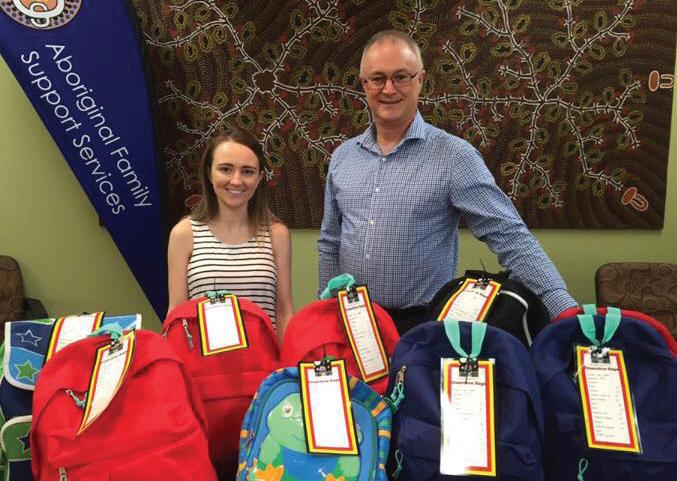
26 January 2018 saw the Adelaide community gather to celebrate the resilience of Aboriginal and Torres Strait Islander peoples.
Each year Tandanya National Aboriginal Cultural Institute hosts an event to acknowledge and reinforce the present and the future of our cultures.
Marking the day in a positive way remains important, according to Tandanya.
“Survival Day embodies the reality that Indigenous cultures are strong, with much to be positive about despite the negative effects of colonisation.”
As in recent years, Tandanya’s event was planned for Semaphore Foreshore with free entertainment, stalls, information, workshop and more. Unfortunately, due to very high temperatures forecast for Semaphore on 26 January, the team had to move the event from Semaphore and relocate it to the Tandanya building in the city.
This was done for the wellbeing of all involved, including artists, stallholders, elders appearing at the event.
The Survival Day events continued as planned and a large crowd visited, with MC Jack Ansell kicking of proceedings at 11am and a full day of activities going ahead until 6pm.
Performers on the day included Tal-kin-jeri dance group, Nathan May, Eddie Peters and the Twang Bangers.

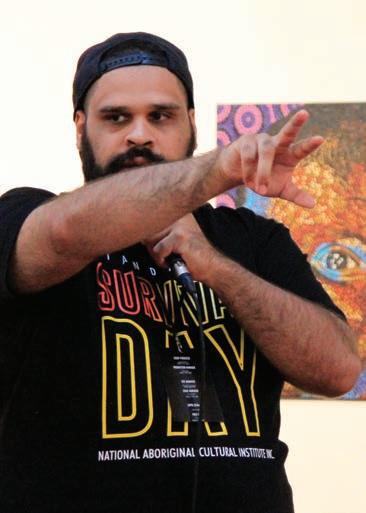
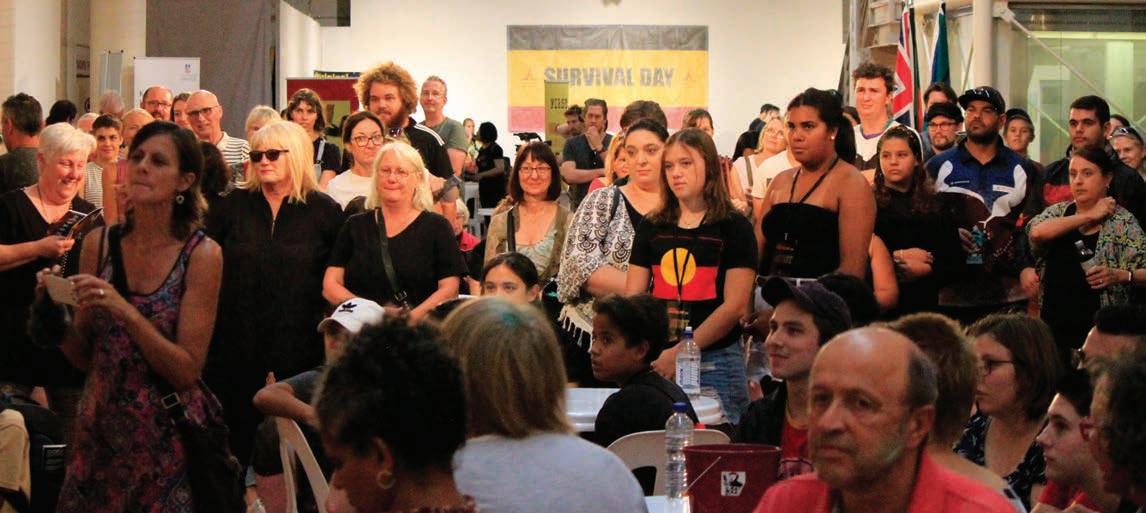
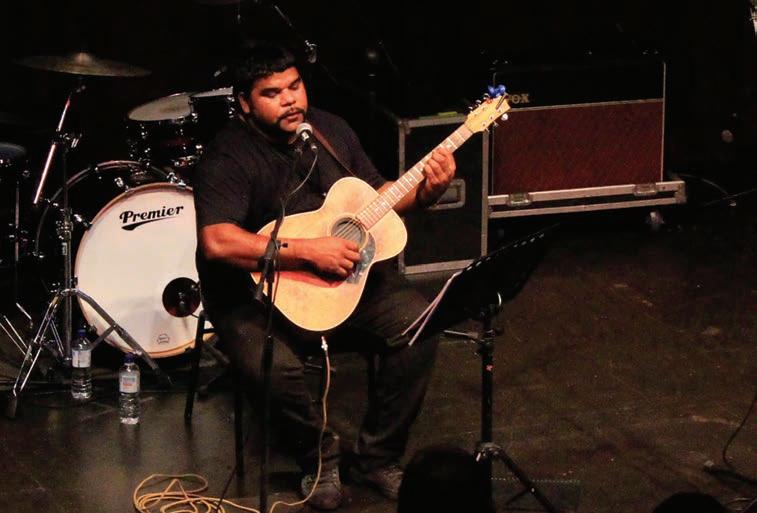
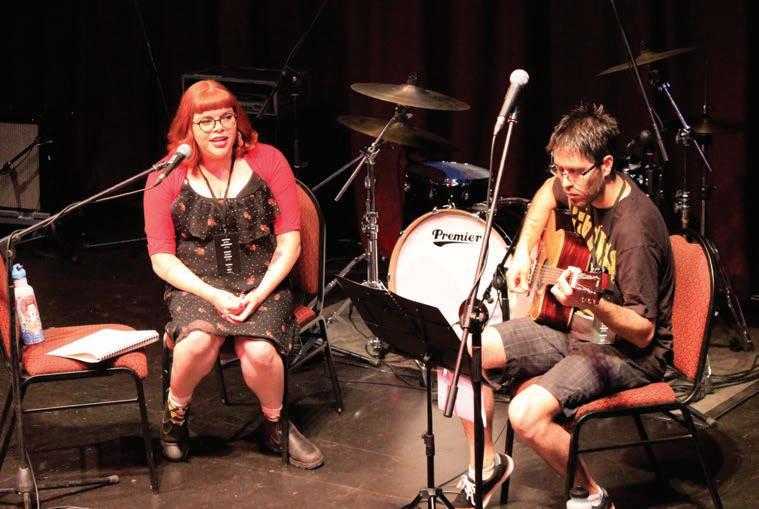
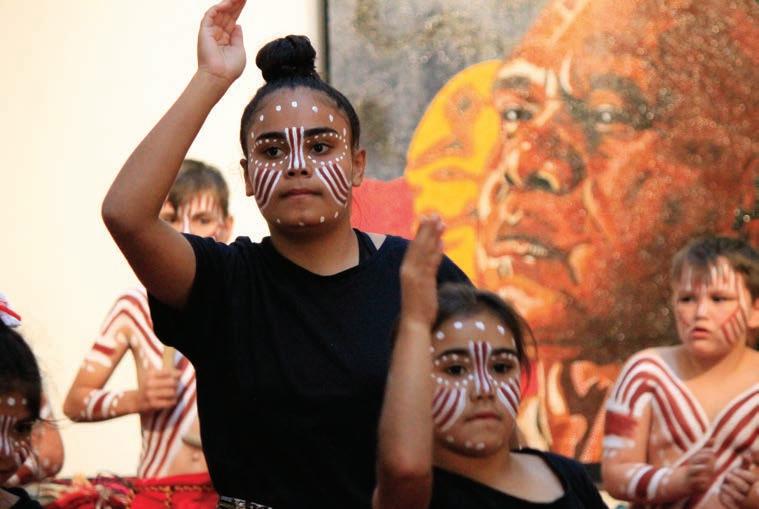
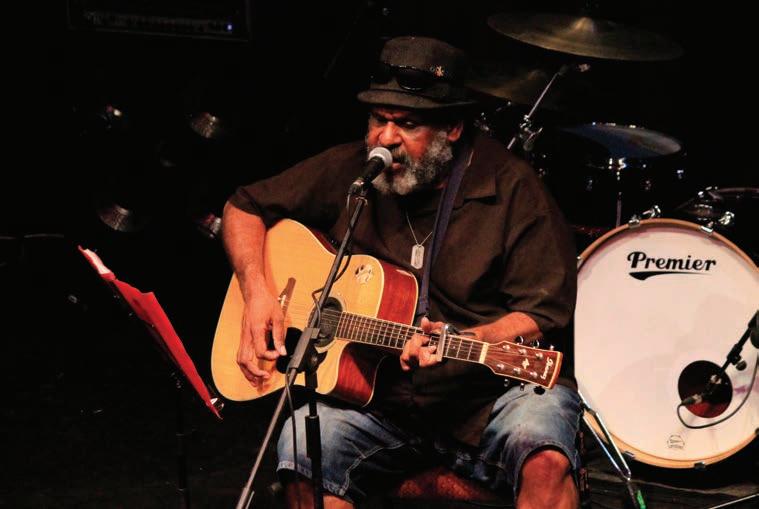
SA Native Title Services (SANTS) continues to work with native title holders and claimants, their representatives and other stakeholders to resolve native title claims currently before the Courts. There are currently twenty native title applications being dealt with in South Australia.
The Adnyamathanha Peoples (Area C & F), Wilyakali No.2 and Ngadjuri Nation
A potential settlement for these overlapping claims in the north east of the state around the Bimbowrie Conservation Park is currently in mediation and community meetings will be held in May 2018.
Wirangu No.2
This claim over an area at the top of the Eyre Peninsula across onto the West Coast is in Case Management with the Federal Court. A Native Title report is being assessed by the State.
Nauo/Nauo No.2/Nauo No.3
These three claims cover an area along the western side of the Eyre Peninsula from the tip at Lincoln National Park up to a line near Smokey Bay. Anthropologists are completing a Native Title Report for consideration by the State and Courts, due by 30 June 2018.
Narungga Nation
The State is now considering supplementary evidence in this claim over the Yorke Peninsula.
Malyankapa
Work continues on the Native Title Report for this claim, which is located in the far east of the State, with the top of the claim in line with the NSW border.
Walka Wani Oodnadatta and Arabana No.2
Mediation for these overlapping claims around Oodnadatta in the north of the state has been scheduled for September, with both parties required to provide the Court with mediation anthropological reports to the Court by the end of August.
Far West Coast Sea claim
This claim is for an area of sea along the coast from Streaky Bay to the Western Australian border. A strike out Application against the applicant has been lodged and is awaiting judgment.
First Nations of the South East No.1 and No.2 and Ngarrindjeri
Overlapping claims over an area covering the south of the Coorong is currently in mediation. Each applicant group is considering a possible joint consent determination approach.
Lake Torrens litigation
An appeal against the decision in this case was not allowed by the Full Federal Court. Native Title parties have now make special leave applications to the High Court. These two claims in the north east of South Australia from the Flinders Ranges to the Barrier highway, and including an area of overlap, are not currently priority matters in the Federal Court.
Port Augusta overlaps (Kokatha No.3, Barngarla and Nukunu)
The City of Port Augusta is located in the centre of these three overlapping claims.
They are not currently priority matters but will move up the list as other claims are finalised.
For a map of current native title Application and Determination areas in South Australia, see the back page of Aboriginal Way.
For an interactive online map of Native Title areas – see Native Title Vision www.ntv.nntt.gov.au
Compensation for Tjayiwara Unmuru Peoples
Late in 2017 the Federal Court awarded compensation to the Tjayiwara Unmuru Peoples for the extinguishment of native title over a small area of land around the Stuart Highway in the far north of South Australia.
The Tjayiwara Unmuru Peoples’ ownership over the land surrounding that area was first recognised in a determination by the Court in July 2013. That determination granted recognition of non-exclusive native title rights and interests over approximately 4500 square kilometres of pastoral land in the central northern part of the state.
In the case, the Tjayiwara Unmuru Peoples have been compensated for the loss of a small parcel of land which was excluded from their 2013 native title determination due to government development on the land. The compensation was for a relatively small portion of the Stuart Highway corridor, which crosses through the Tjayuwara Unmuru determination area and also land where a Digital Radio Concentrator (DRC) Tower now sits.
Deputy Principal Legal Officer Osker Linde, who represented the Tjayuwara Unmuru people in the application said that it was a complex negotiation for all involved.
“The compensation case was a complicated one, because the evidence was largely restricted men’s evidence. It had never been written down by anyone, and no ethnographic information was available to substantiate the evidence prior to conducting field work with the compensation claim group in 2013. “For this reason, we commissioned an independent anthropological report, undertaken by Associate Professor Jon Willis, who himself has been through western desert law ceremonies. The State got their own anthropologist to test the veracity of the claimant evidence” he said.
During the negotiations over the claim, the Nguraritja (traditional owners) provided the State with testimony about the impact of the extinguishment.
The Tjyiwara Unmuru People said that the Stuart Highway has cut their tjukurpa (creation stories and laws) in three different places, causing irreversible damage to the cultural landscape and to practices, laws and customs. They also said that the Digital Radio Concentrator tower was built in a sacred area and is an impediment to the tjukurpa track, as it travels from one site in the determination area to another.
The Tjyiwara Unmuru people said that the road and tower have interfered with the pathway of a particular highly restricted men’s tjukurpa. There is a ceremony associated with this tjukurpa which is of the highest importance which only men of high seniority can participate. The details of the tjukurpa and its association with the determination area have never been recorded publicly.
Mr Linde says that the State accepted the evidence of the traditional owners and both sides worked to resolve the claim through agreement.
“In the end, the State did not challenge the evidence of the claim group that the relevant act being compensated did relate to the law that the men were describing” he said. “The claimant group and the State both made significant compromises to reach a mutually agreeable settlement of the issue.
The amount of compensation paid remains confidential. Both the State and the Tjayiwara Unmuru People asked the Court for this information to be suppressed. This request was made to the Court partly because of the complexity of the negotiations and partly because of the applicant’s desire to avoid further disclosure of the highly secret men’s law.
“No doubt front and centre in the minds of the claim group was the desire to not put their senior men through what could potentially be an open hearing in relation to their restricted men’s evidence” Mr Linde said.
“Even if the Court was closed under orders for gender restrictions, the experience of SANTS in the Full Court of the Federal Court in a different matter, was that there could be no guarantee that the Federal Court will agree for example, to have an all-male bench hear any appeal, even where men’s restricted evidence would be read out and considered by the Full Court.”
Justice White told the Court that the order for suppression was appropriate given the policy of the Native Title Act to encourage the resolution of matters by agreement, and that this being an early compensation case, the parties had conducted their negotiations on the basis of an expectation of confidentiality.
According to Mr Linde, he also made it clear that in future, when principles of native title compensation become more settled, the Court may not consider it appropriate to supress compensation settlement amounts.

SANTS Lawyer Osker Linde (centre) with Tjayiwara Unmuru Claimants outside Federal Court.
South Australia’s Yorke Peninsula was a place of celebration of Narungga culture on the January long weekend, with Gynburra 2018. It’s a festival that draws on the traditions of the First People of the Guuranda, the Narungga name for the Yorke Peninsula, to create a fun, inclusive family weekend.
The Director of Gynburra 2018 Garry Goldsmith, says it’s an important event for Narungga people.
“Gynburra is an event that celebrates our connection to Guurunda, both our spiritual and cultural connection to that country” he said.
At the core of the festival is a fishing competition that that has been taking place in the waters off Port Victoria each year for around 50 years.
“We’ve been having an event called the Clem Graham Memorial Butterfish competition, which allows men and boys from Narungga to compete in a spearfishing competition to hunt Gynburra, which is butterfish or otherwise known as a Dusky Morwong” Mr Goldsmith said.
“So, this competition was mainly for the men and the boys to continue that traditional fishing practice, to provide a feed, and also to win the accolade of the Butterfish King, the person that catches the biggest fish on the day” he explained.
It’s a competition that draws on older traditions of the Narungga community, Mr Goldsmith explains.
“Our people used to use harpoons to hunt this fish. So, there is that cultural connection from passing on knowledge from men to young boys, to continue to get a feed and bring it to your families, and to your community, to celebrate” he said.
In the past few years, the event has broadened beyond the fishing competition to include activities for the families waiting back on shore.
“From then, it’s just grown in stature and also in attendance with not only the Narungga nation, local people, and the greater Yorke Peninsula community” said Mr Goldsmith.
From having 15 entrants in the competition some years back, the Butterfish King competition has grown and over 100 fishermen were involved this year. The growth is a result of more people visiting for the wider festival says Mr Goldsmith.
“People from across South Australia are now coming back to country to celebrate Gynburra because it accommodates everyone, from young and old, to men and women, to Aboriginal, non-Aboriginal” Mr Goldsmith said.
Activities over the weekend included a lunch for elders and a family fun day, which include live music, a jumping castle and waterslide as well as a movie on the beach.
For Mr Goldsmith Gynburra is an event that supports the recognition of the Narungga as traditional owners of the area.
“You know, for too long on Yorke Peninsula, the recognition and acknowledgement of the Narungga people as traditional owners, has been somewhat lost. Including within our own community, you know, most of us are around central Yorke Peninsula. But we have a beautiful country over here, right down from the bottom end at Marion Bay, right up to the top, towards Port Broughton, and, you know, from east and west” he said. “We can’t, obviously, get any land back, but what we can claim is that connection to country and have an acknowledgement internally, and also with the wider community.
“So we’re saying: look, come and celebrate with the Narungga nations, learn a bit more about the history of Narungga and our people” said Mr Goldsmith.
The Gynburra 2018 festival took place at Point Pearce and Port Victoria from Thursday 25 January until Saturday 27 January 2018.
More details at www.gynburra.com
Clem Graham Snr Butterfish King Phillip Dudley
Wayne Newchurch Snr Most Butterfish Kevin Newchurch
Geoffrey ‘Scooby’ Webb Butterfish Prince Fahl Wanganeen
Neville O’Loughlin Most Butterfish – Joint winner Tyson Baker
